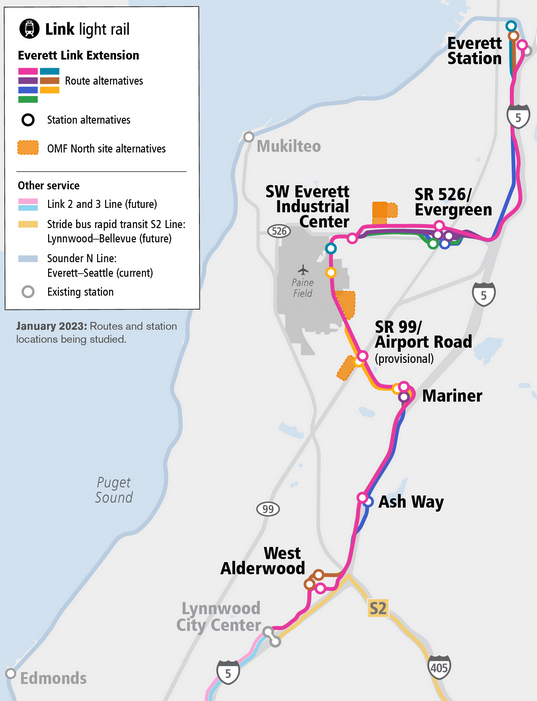
SEATTLE — Sound Transit has advanced the process of designing a light rail line that would extend to Everett, Wash., with the agency’s board voting Thursday on potential station sites for the 16-mile extension north from the line to Lynnwood, Wash., that is now under construction.
The Seattle Times reports plans approved Thursday would not bring the line to the Amtrak station in Everett, but would have a downtown terminal at Angel of the Winds Arena, a 10,000-seat facility primarily used by a junior hockey team, or at the Snohomish County Civic Campus. Depending on the precise location, either choice could leave up to a half-mile gap between the light rail and Amtrak stations.
When funded by voters, the extension was targeted for completion in 2036, but length of the design process and an inflation-fueled funding shortfall of up to $600 million now mean opening is more likely for 2041. If Sound Transit opts for a two-stage construction process, the first part, reaching the area of Boeing’s Everett plant, could open by 2037.
Thursday’s 9-0 vote by the board authorizes environmental studies to complete 10% of the engineering for the right-of-way and seven planned stations. Current cost estimates for the extension range from $5.05 billion to $6.9 billion, the Times reports, plus $1.5 billion to $2.2 billion for a maintenance facility.













You’re comparing apples and oranges. That $2BN budget is for capital projects as well. In the last year before the pandemic Sound Transit’s farebox recovery rate was 25%, which is pretty normal.
From a ST report:
In 2021, Link had an increase in farebox recovery rate over 2020 while the other modes dropped due to reduced ridership as a result of the pandemic and economic conditions.
• Link farebox revenue was 10% of operating costs in 2021 and 34% in 2019; lower than the 40% minimum policy threshold.
• ST Express bus farebox revenue was 7% of operating costs in 2021; lower than the 20% minimum policy threshold and lower than the 25% farebox recovery in 2019.
• Sounder farebox revenue was 5% of operating costs in 2021; lower than the 23% minimum policy threshold and lower than the 31% farebox recovery in 2019.
So yeah, it’s about the pandemic. Just like everything else.
As I took the Sound Transit Link from Sea-Tac to the City Center a few weeks ago, no one, repeat no one was checking for the e-Tickets on ones phone or device. The ORCA scanners sat unused. People were able to board and exit with no validation. I am not sure if this is a remnant of covid or what, but when this system is done, they are going to have to crack down on fare compliance or they will go broke.
Unlike other agencies like BART, Sound Transit is heavily funded by taxes and does not rely on fare revenue to stay afloat. If you look at their 2023 budget, out of the forecasted $2.68 billion in revenue sources, less than 2% ($52 million) of that is estimated to come from fare revenue while 85.5% ($2.3 billion) of it is estimated to come from taxes.